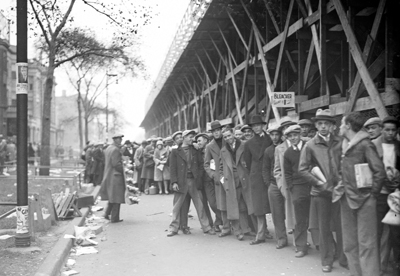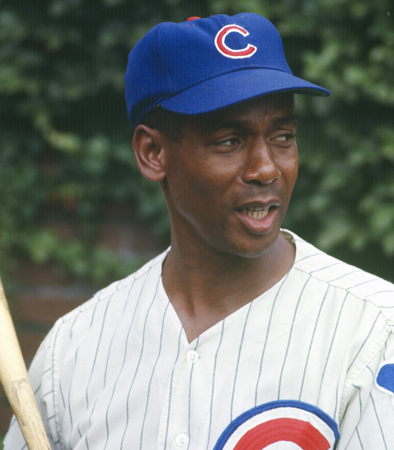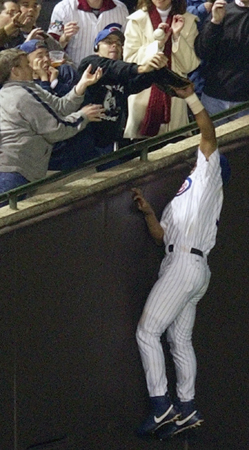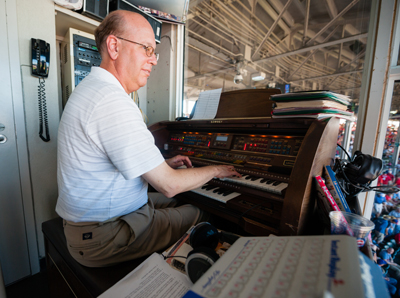Bum rush
Cubs hall of famer Billy Williams developed a close relationship with Wrigley Field’s original bleacher bums
 |
Fans line up for bleacher seats in Wrigley’s early days.
Photo by: Chicago History Museum |
during his 16 years patrolling the outfield in Chicago.
In the 1960s, a loyal group of fans sat together in the left-field bleachers and bonded through several losing seasons before the Cubs finally became a contender in 1969. The group became the subject of “Bleacher Bums,” a 1977 play written by actor Joe Mantegna, as well as a made-for-television movie and several books.
{podcast}
SBJ Podcast:
MLB writer Eric Fisher and facilities reporter Don Muret on Wrigley Field's first 100 years, what the park means to Chicago and what its future holds
“Because of Wrigley’s dimensions, the people are so close to you, so you could practically hear everything they say,” Williams said. “Playing left field, I knew most of the guys. … I remember one kid by the name of Ronnie [Grousl] who used to play the trumpet. I don’t think he’s hit any notes yet, but they had a great time. It wasn’t a rowdy group of guys; they just drank a lot of beer and enjoyed the game of baseball.
“This is one of the reasons why you see the [wire bucket rimming] the outfield wall. It wasn’t really for the umpires, although it was a tough thing for them to see home runs when people reached over the wall [to catch the ball.] But a couple of bleacher bums used to drink a lot of beer, and they fell over on the field. They would come early in the morning [and] stay after the game 45 minutes later. They had to run them out. I have a bleacher bum card at home — I was an honorary bleacher bum.”
Before the lights came on
 |
Ernie Banks
Photo by: Getty Images |
“Mr. Cub” Ernie Banks played all day games at Wrigley Field. His 19-year Cubs career ended in 1971, and Wrigley Field did not have its first night game until August 1988. As a result, he felt the Cubs had a decided advantage at home and a big disadvantage on the road having to adjust to playing night games.
“There are many ways you can take advantage of the opposition, and I always thought we should win every game we played at Wrigley,” Banks said. “I used to get on Willie Mays and Hank Aaron and Stan Musial. They liked the day schedule too and the wind blowing out. I would trick some players into going to Rush Street [the downtown Chicago bar district], and they would stay until 3 a.m. and come back to the park the next day and couldn’t see. I
wasn’t there with them — but I told them where to go.”
Bartman game
Carl Rice, the Cubs’ vice president of stadium operations, shared his unique perspective of Game 6 of the 2003
 |
Fan Steve Bartman takes his place in Cubs history.
Photo by: AP Images |
National League Championship Series at Wrigley Field. The Marlins rallied to beat the Cubs and later won Game 7 to advance to the World Series.
Game 6 will forever be known for the eighth-inning foul ball that eluded Cubs left fielder Moises Alou and was deflected by Cubs fan Steve Bartman. The Cubs were five outs away from reaching their first World Series in 58 years, and Bartman was vilified by many.
“I was overseeing the postseason, and honestly, half my brain was in World Series mode,” Rice said. “All we have to do is win one more game. The NLCS trophy had never been presented in front of the crowd, and we were going to take the trophy and have MLB award it to us in the stadium so the fans could experience that moment. … But we also knew it was going to be a large celebration in the clubhouse. I made a statement in a meeting earlier that day with [Fox] production that we could not put anything up in the clubhouse until after the Marlins completed their third out in the top of the eighth inning. You need time to prepare, and there’s a little curse thing you’re playing, but all you need to do is get three more outs in the 9th.
“I get a radio call, and Fox is trying to get things set up in the clubhouse because everybody thinks we’re going to win. [Cubs pitcher Mark] Prior is cruising along. I go down there and I’m not happy. There is one out in the eighth and nobody’s on base yet. I said, ‘Guys, stop,’ but they just keep going along. I leave the clubhouse and go to the interview room under the stands, just to have my moment of relaxation, and what do I walk into but the NLCS trophy, a security guard sitting with it. I watch it [all unfold] on TV in the bowels of the stadium with the trophy sitting on a table.”
Dust in the wind
Over Wrigley’s 100 years of existence, many die-hard Cubs fans have had their cremated remains dumped at the historic ballpark — “officially and unofficially,” according to Cubs historian Ed Hartig, who gave tours of the facility for about 20 years.
In years past, longtime season-ticket holders who received the team’s blessing could have their ashes spread at the park, and it was not uncommon for Hartig to see a “little gray clump” somewhere on the field during his tours, he said. More recently, however, the city health department has limited the practice, Hartig said. Charlie Grimm, manager of the Cubs in 1945, the last time the team won the National League pennant, died in 1983, and his widow was permitted to spread his ashes at Wrigley.
During one game in the late 1990s, Cubs outfielder Brian McRae turned around to the bleachers and “saw a big puff of smoke” after a fan threw some cremated remains in the air, Hartig said. After the game, McRae told reporters “I think that was someone’s Uncle Steve or something like that,” Hartig said. “Brian said he was a little creeped out by that.”
Organ man
 |
Gary Pressy has played the organ at Wrigley since 1987. He looks forward to one day playing “We Are the Champions.”
Photo by: Getty Images |
Wrigley Field is one of the few remaining major league ballparks to have live organ music. Gary Pressy has operated the keyboards at the corner of Clark and Addison since 1987.
As part of his organ duties, Pressy accompanies the seventh-inning-stretch singer in a tradition started by the late Cubs broadcaster Harry Caray in the early 1980s. The Cubs have used celebrity singers since Caray’s death in 1998.
Former Chicago Bears player and coach Mike Ditka and Black Sabbath frontman Ozzy Osbourne stand out in Pressy’s mind for their unique versions of “Take Me Out to the Ballgame.”
Ditka rushed his rendition after reportedly arriving late to the park following a round of golf. His face was beet-red from the summer sun and he was out of breath from running up the ramp to get to the broadcast booth.
“If you look at the scoresheet of that game, the Cubs were losing,” Pressy said. “I call it the Knute Rockne version. I think we scored like six runs in the eighth inning and came back to beat Pittsburgh, so maybe [he] inspired all the players.”
On Osbourne’s tortured take, in which he fumbled the lyrics, Pressy said, “I guess he sang it backwards.”
Early in his career at Wrigley, Pressy would play “I Wish I was in Dixie” for Cubs catcher Jody Davis, a Georgia native who would put his hand over his heart as he approached the batter’s box. Cubs outfielder Keith Moreland, a former University of Texas football defensive back, would flash the “Hook ‘em Horns” sign while Pressy played the “Eyes of Texas” before his at-bats.
The one song Pressy said he has never played at Wrigley is “We Are the Champions,” by British rock band Queen. He’ll wait to push the pedals on that tune until after the Cubs win the World Series.
“That would be great,” he said, “‘hopefully one of these years.”
Poison Ivy
During the 2002 baseball season, there were reports of somebody allegedly trying to poison a portion of Wrigley Field’s famed ivy along the outfield walls. It came during a Cubs-White Sox game, and witnesses said they saw someone at the top of the wall “doing something to the ivy,” said team historian Ed Hartig.
“A series or two later, the Cubs were playing the Rangers, and you looked out there, and there’s a section that looked like it was burned out. It was probably a chemical of some sort that killed it. The Cubs wound up cutting that area out and did a ‘combover’ a little bit, and it eventually came back. … The Cubs blamed it on the White Sox fans.”
The FBI comes calling
Cubs President Crane Kenney had no idea his talks with former Illinois Gov. Rod Blagojevich for financing Wrigley Field upgrades would be part of a federal corruption case against the Chicago-based politician.
Kenney’s tenure with the Cubs dates to when Tribune Co. owned the team before selling it the Ricketts family in 2009. The previous year, Tribune Co. filed for bankruptcy protection and sought public money to pay for a major ballpark renovation. Kenney approached Blagojevich, a Cubs fan who grew up on Chicago’s North Side, with a plan to transfer ownership of Wrigley Field to the Illinois Sports Facilities Authority. In turn, the authority would be responsible for financing Wrigley improvements and would let Tribune Co. off the hook for the project.
Kenney’s phone calls with Blagojevich were part of the evidence gathered by the FBI in its case against the governor.
“I called the governor to tap into the ISFA, and we had lunch at the park and went to a Cubs game,” Kenney said. Later on, Kenney got a call from the FBI deposing him in the Blagojevich case. “I went through a 4 1/2-hour deposition,” he said. “They had me on tape, and it was really unnerving.”
Blagojevich was later indicted, tried and convicted on charges unrelated to the Cubs’ situation and sent to prison. Former Tribune Co. Chairman Sam Zell ultimately rejected the Cubs’ plan to sell Wrigley to the authority. Instead, he sold the team and the ballpark to the Ricketts family.







